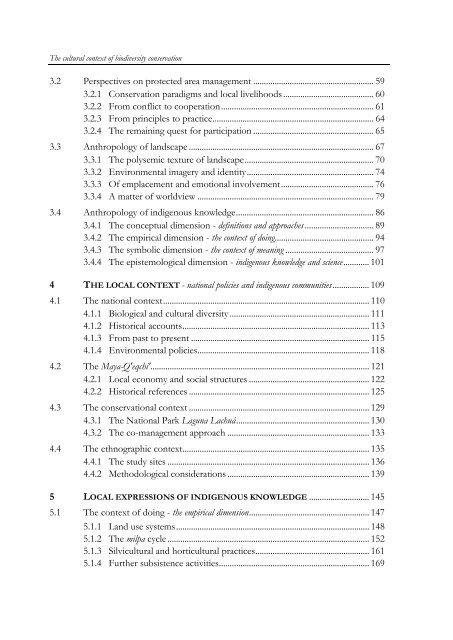The cultural context of biodiversity conservation - Oapen
The cultural context of biodiversity conservation - Oapen
The cultural context of biodiversity conservation - Oapen
You also want an ePaper? Increase the reach of your titles
YUMPU automatically turns print PDFs into web optimized ePapers that Google loves.
<strong>The</strong> <strong>cultural</strong> <strong>context</strong> <strong>of</strong> <strong>biodiversity</strong> <strong>conservation</strong><br />
3.2 Perspectives on protected area management ........................................................ 59<br />
3.2.1 Conservation paradigms and local livelihoods .......................................... 60<br />
3.2.2 From conflict to cooperation....................................................................... 61<br />
3.2.3 From principles to practice........................................................................... 64<br />
3.2.4 <strong>The</strong> remaining quest for participation ........................................................ 65<br />
3.3 Anthropology <strong>of</strong> landscape ...................................................................................... 67<br />
3.3.1 <strong>The</strong> polysemic texture <strong>of</strong> landscape............................................................ 70<br />
3.3.2 Environmental imagery and identity........................................................... 74<br />
3.3.3 Of emplacement and emotional involvement........................................... 76<br />
3.3.4 A matter <strong>of</strong> worldview .................................................................................. 79<br />
3.4 Anthropology <strong>of</strong> indigenous knowledge................................................................ 86<br />
3.4.1 <strong>The</strong> conceptual dimension - definitions and approaches ................................ 89<br />
3.4.2 <strong>The</strong> empirical dimension - the <strong>context</strong> <strong>of</strong> doing.............................................. 94<br />
3.4.3 <strong>The</strong> symbolic dimension - the <strong>context</strong> <strong>of</strong> meaning ......................................... 97<br />
3.4.4 <strong>The</strong> epistemological dimension - indigenous knowledge and science............ 101<br />
4 THE LOCAL CONTEXT - national policies and indigenous communities................. 109<br />
4.1 <strong>The</strong> national <strong>context</strong>................................................................................................ 110<br />
4.1.1 Biological and <strong>cultural</strong> diversity ................................................................. 111<br />
4.1.2 Historical accounts....................................................................................... 113<br />
4.1.3 From past to present ................................................................................... 115<br />
4.1.4 Environmental policies................................................................................ 118<br />
4.2 <strong>The</strong> Maya-Q'eqchi'...................................................................................................... 121<br />
4.2.1 Local economy and social structures ........................................................ 122<br />
4.2.2 Historical references .................................................................................... 125<br />
4.3 <strong>The</strong> <strong>conservation</strong>al <strong>context</strong> .................................................................................... 129<br />
4.3.1 <strong>The</strong> National Park Laguna Lachuá.............................................................. 130<br />
4.3.2 <strong>The</strong> co-management approach .................................................................. 133<br />
4.4 <strong>The</strong> ethnographic <strong>context</strong>....................................................................................... 135<br />
4.4.1 <strong>The</strong> study sites .............................................................................................. 136<br />
4.4.2 Methodological considerations .................................................................. 139<br />
5 LOCAL EXPRESSIONS OF INDIGENOUS KNOWLEDGE ............................ 145<br />
5.1 <strong>The</strong> <strong>context</strong> <strong>of</strong> doing - the empirical dimension........................................................ 147<br />
5.1.1 Land use systems.......................................................................................... 148<br />
5.1.2 <strong>The</strong> milpa cycle .............................................................................................. 152<br />
5.1.3 Silvi<strong>cultural</strong> and horti<strong>cultural</strong> practices..................................................... 161<br />
5.1.4 Further subsistence activities...................................................................... 169

















